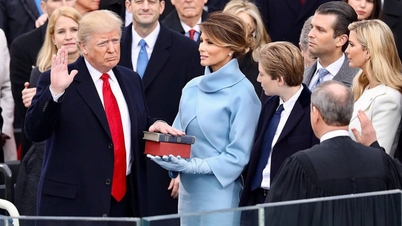On November 5, 2024, American voters will go to the polls in the 60th general election of the United States, in which the most important decision is to choose the president who will lead the country for the next 4 years. The focus of this year's election season, which is considered dramatic and unpredictable, is the race between two candidates with many differences in election commitments, including Vice President Kamala Harris of the Democratic Party and former President Donald Trump of the Republican Party.
 |
| Kamala Harris and Donald Trump debated live on September 10, 2024. (Photo: REUTERS) |
The statutory election process The US law sets the date for the presidential election (every four years) as “the Tuesday after the first Monday in November”, which is the Tuesday of the week from November 2 to November 8. The winning candidate becomes the US President based on the results of the votes of the Electoral College (consisting of 538 electors) rather than through a majority of the national popular vote. When voting, voters vote for the presidential and vice presidential candidates running together, but their votes, called popular votes, are only responsible for choosing electors for their state. The number of electors is allocated to the 50 states and the capital Washington DC, mainly based on the population of each state. “Battleground states”, also known as “swing states”, are the term for states whose results are difficult to predict but play a key role in deciding the winning candidate and change over the election cycle according to economic and demographic trends in each state. In the US, some states traditionally vote for the Democratic Party, such as California, New York, and some others support the Republican Party, such as Oklahoma, Alabama. In 2020, of the 538 electoral votes, the “battleground states” accounted for more than 17%. Most states in the US allow voters to vote early (except Alabama, Mississippi and New Hampshire), as early as September 20 (in some states such as Minnesota, South Dakota and Virginia). In the 2020 White House race, about 70% of the 154.6 million US voters voted early, either in person or by mail. A few states and the capital Washington DC hold elections entirely by mail, whereby all registered voters are sent ballots to vote and return before Election Day. The 46th President of the United States, Joe Biden, has withdrawn from his campaign for a second term, thereby creating an opportunity for Vice President Kamala Harris to be nominated as the Democratic Party's representative to compete with former President Donald Trump of the Republican Party for the 47th presidential seat of the United States. In case of victory in this 60th general election, Mr. Donald Trump (the 45th president) will be the second person in US history to hold power for two non-consecutive terms, after President Grover Cleveland, the 22nd and 24th President of the United States, who held power from 1885 to 1889 and from 1893 to 1897. The election is unpredictable. From the beginning of the campaign to the final weeks of the sprint, both candidates have tried to take advantage of the opportunity to emphasize economic commitments, a topic that attracts special attention from American voters. In September 2024, the campaign of US Vice President Kamala Harris announced a new election policy platform with the theme "A New Way Forward", which highlighted the economic and foreign policy agenda, as well as key goals if Ms. Harris wins the election. In terms of economy, Ms. Harris's administration plans to cut taxes for more than 100 million working-class and middle-class Americans, reduce daily living expenses through measures such as tax assistance for families with children, low- and middle-income people, credit support for first-time homebuyers, extending the price cap on diabetes drugs and the cap on medical payments... Meanwhile, former US President Donald Trump affirmed a strong commitment to tackling inflation, boosting energy production and improving the living standards of the American people. Campaigning in North Carolina on August 14, Donald Trump announced plans to reverse President Joe Biden's restrictions on fossil fuel production, use all necessary tools to cool inflation in his first year in office, and abolish taxes on social security benefits. Trump also affirmed that economic growth will help the US pay off its debt, while pledging to reduce energy prices by up to 70%. The Republican presidential candidate announced that he would implement measures to control inflation. The solution to boost the US economy is focused on by both Vice President Kamala Harris and former President Donald Trump, aiming to please undecided voters. Both candidates have made commitments to promote investment in the US manufacturing industry. While Ms. Harris pledged to "chart a new path forward", Mr. Trump emphasized the plan to impose comprehensive tariffs on imports. Besides the economy, immigration is also an important issue for the US. In an interview with Fox News on October 16, US Vice President Kamala Harris emphasized that the failure to pass a bipartisan immigration bill from the previous term was the main reason for the increase in immigration. US Vice President Kamala Harris has also repeatedly declared that she will be tougher on immigration issues at the southern border with Mexico. She affirmed that she will continue to promote comprehensive border laws to tighten immigration into the US, and at the same time declared that she will severely punish those who cross the border illegally. Ms. Harris's tough stance on immigration is seen as an effort to score points in the race to the White House, in the context that the Republican Party considers immigration a spearhead to attack the Democratic candidate. In fact, when running for US president, Mr. Trump always considered tightening immigration management as the focus of his agenda. Even during the election campaign in Wisconsin in June 2024, the Republican candidate declared that if elected, he would deport a large number of illegal immigrants. In addition to domestic issues, the two US presidential candidates also made great efforts to win over voters with their commitments to US foreign policy. Not only did they promote international experience and the image of Vice President Kamala Harris as a tireless and effective diplomat , the Democratic Party's election campaign also affirmed that Ms. Harris is ready to confront to protect US interests, promote peace in hot spots, including the crisis in the Gaza Strip. Meanwhile, Republican candidate Donald Trump also attracted attention with his statement that he has solutions to end the crises in Ukraine and the Middle East. The tense confrontation between Ms. Kamala Harris and Mr. Donald Trump is not only a race between two candidates with many differences, but also a competition to choose a direction for the future of the US. However, whoever wins the election will face many challenges, focusing on economic, immigration and foreign affairs issues.
Important milestones of the general election - November 5, 2024: Election Day. - Late November 2024: Official results are announced. - December 17, 2024: 538 electors, or the Electoral College, meet in their respective states and Washington, DC, to elect the President and Vice President. - December 25, 2024: Deadline for receiving the Electoral College votes. The President of the Senate (a position held by the incumbent Vice President) and the Librarian are responsible for receiving them. - January 6, 2025: The incumbent Vice President presides over the counting of the 538 Electoral College votes at a joint session of Congress (both houses), announces the results and declares the winner. - January 20, 2025: Inauguration of the President and Vice President of the United States, taking place at the Capitol, Washington, DC (According to Reuters)
The “battleground states” in the last 5 elections: - 2004: Iowa, Nevada, New Hampshire, New Mexico, Ohio, Pennsylvania and Wisconsin. - 2008: North Carolina, Florida, Indiana, Missouri and Montana. - 2012: North Carolina, Florida and Ohio. - 2016: Florida, Michigan, Maine, Minnesota, Nevada, New Hampshire, Pennsylvania and Wisconsin. - 2020: Arizona, North Carolina, Georgia, Michigan, Nevada, Pennsylvania and Wisconsin. (According to Reuters)
Nhandan.vn
Source: https://nhandan.vn/cuoc-tong-tuyen-cu-lan-thu-60-tai-my-post842441.html




![[Photo] Prime Minister Pham Minh Chinh and Prime Minister of the Kingdom of Thailand Paetongtarn Shinawatra attend the Vietnam-Thailand Business Forum 2025](https://vphoto.vietnam.vn/thumb/1200x675/vietnam/resource/IMAGE/2025/5/16/1cdfce54d25c48a68ae6fb9204f2171a)























![[Photo] Many people and tourists come to the photo exhibition "Bright Name of the Person"](https://vphoto.vietnam.vn/thumb/402x226/vietnam/resource/IMAGE/2025/5/16/de2c8ad0828f4883bbdeb4f84a074a05)





![[Photo] President Luong Cuong receives Prime Minister of the Kingdom of Thailand Paetongtarn Shinawatra](https://vphoto.vietnam.vn/thumb/1200x675/vietnam/resource/IMAGE/2025/5/16/52c73b27198a4e12bd6a903d1c218846)




























































Comment (0)